Comprehensive Report on the SAP Enterprise Support SLA Framework
VerifiedAdded on 2021/04/21
|8
|2785
|89
Report
AI Summary
This report provides a detailed analysis of the Service Level Agreement (SLA) for SAP Enterprise Support, focusing on the key components and implications of the agreement. The report begins with an executive summary and company profile, highlighting SAP's position as a leading enterprise application provider. It then outlines the business requirements, key stakeholders, and proposed solutions for implementing the SAP Enterprise Support system, including a centrally managed collaboration platform. The report details the advantages and disadvantages of the proposed solution, followed by a comprehensive description of the SLA, covering the duration of the contract, areas of support, methods and levels of support, hours of support, and the definition of priority levels and response times. Furthermore, it explores communication methods, IT support personnel roles and responsibilities, SLA implementation, warranties, exclusions, and customer responsibilities, as well as the processes for service level monitoring, handling complaints, and making changes to the SLA. Finally, it concludes with IT resource requirements and a list of references, providing a complete overview of the SAP Enterprise Support SLA and its practical applications.
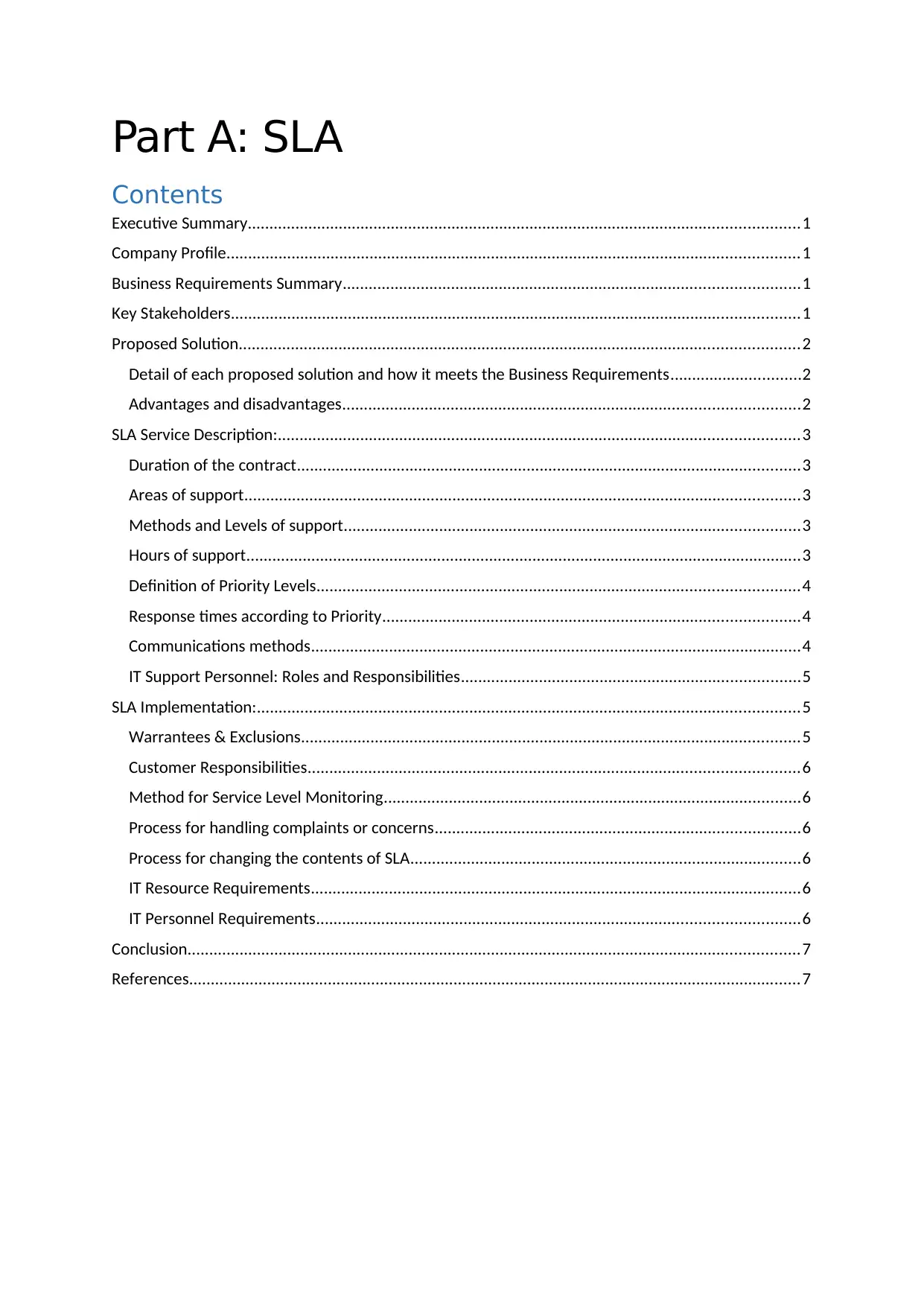
Part A: SLA
Contents
Executive Summary...............................................................................................................................1
Company Profile....................................................................................................................................1
Business Requirements Summary.........................................................................................................1
Key Stakeholders...................................................................................................................................1
Proposed Solution.................................................................................................................................2
Detail of each proposed solution and how it meets the Business Requirements..............................2
Advantages and disadvantages.........................................................................................................2
SLA Service Description:........................................................................................................................3
Duration of the contract....................................................................................................................3
Areas of support................................................................................................................................3
Methods and Levels of support.........................................................................................................3
Hours of support................................................................................................................................3
Definition of Priority Levels...............................................................................................................4
Response times according to Priority................................................................................................4
Communications methods.................................................................................................................4
IT Support Personnel: Roles and Responsibilities..............................................................................5
SLA Implementation:.............................................................................................................................5
Warrantees & Exclusions...................................................................................................................5
Customer Responsibilities.................................................................................................................6
Method for Service Level Monitoring................................................................................................6
Process for handling complaints or concerns....................................................................................6
Process for changing the contents of SLA..........................................................................................6
IT Resource Requirements.................................................................................................................6
IT Personnel Requirements...............................................................................................................6
Conclusion.............................................................................................................................................7
References.............................................................................................................................................7
Contents
Executive Summary...............................................................................................................................1
Company Profile....................................................................................................................................1
Business Requirements Summary.........................................................................................................1
Key Stakeholders...................................................................................................................................1
Proposed Solution.................................................................................................................................2
Detail of each proposed solution and how it meets the Business Requirements..............................2
Advantages and disadvantages.........................................................................................................2
SLA Service Description:........................................................................................................................3
Duration of the contract....................................................................................................................3
Areas of support................................................................................................................................3
Methods and Levels of support.........................................................................................................3
Hours of support................................................................................................................................3
Definition of Priority Levels...............................................................................................................4
Response times according to Priority................................................................................................4
Communications methods.................................................................................................................4
IT Support Personnel: Roles and Responsibilities..............................................................................5
SLA Implementation:.............................................................................................................................5
Warrantees & Exclusions...................................................................................................................5
Customer Responsibilities.................................................................................................................6
Method for Service Level Monitoring................................................................................................6
Process for handling complaints or concerns....................................................................................6
Process for changing the contents of SLA..........................................................................................6
IT Resource Requirements.................................................................................................................6
IT Personnel Requirements...............................................................................................................6
Conclusion.............................................................................................................................................7
References.............................................................................................................................................7
Paraphrase This Document
Need a fresh take? Get an instant paraphrase of this document with our AI Paraphraser
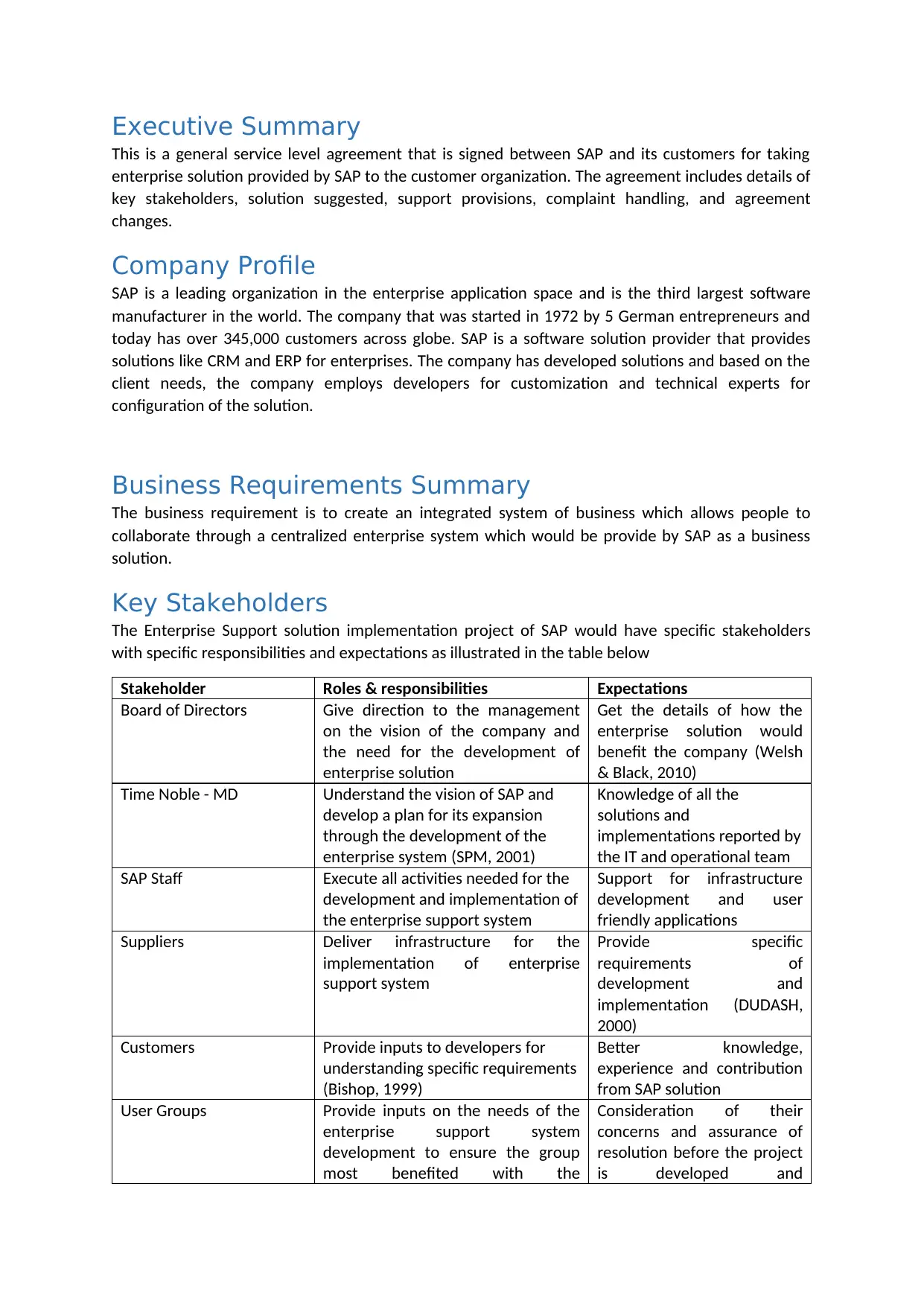
Executive Summary
This is a general service level agreement that is signed between SAP and its customers for taking
enterprise solution provided by SAP to the customer organization. The agreement includes details of
key stakeholders, solution suggested, support provisions, complaint handling, and agreement
changes.
Company Profile
SAP is a leading organization in the enterprise application space and is the third largest software
manufacturer in the world. The company that was started in 1972 by 5 German entrepreneurs and
today has over 345,000 customers across globe. SAP is a software solution provider that provides
solutions like CRM and ERP for enterprises. The company has developed solutions and based on the
client needs, the company employs developers for customization and technical experts for
configuration of the solution.
Business Requirements Summary
The business requirement is to create an integrated system of business which allows people to
collaborate through a centralized enterprise system which would be provide by SAP as a business
solution.
Key Stakeholders
The Enterprise Support solution implementation project of SAP would have specific stakeholders
with specific responsibilities and expectations as illustrated in the table below
Stakeholder Roles & responsibilities Expectations
Board of Directors Give direction to the management
on the vision of the company and
the need for the development of
enterprise solution
Get the details of how the
enterprise solution would
benefit the company (Welsh
& Black, 2010)
Time Noble - MD Understand the vision of SAP and
develop a plan for its expansion
through the development of the
enterprise system (SPM, 2001)
Knowledge of all the
solutions and
implementations reported by
the IT and operational team
SAP Staff Execute all activities needed for the
development and implementation of
the enterprise support system
Support for infrastructure
development and user
friendly applications
Suppliers Deliver infrastructure for the
implementation of enterprise
support system
Provide specific
requirements of
development and
implementation (DUDASH,
2000)
Customers Provide inputs to developers for
understanding specific requirements
(Bishop, 1999)
Better knowledge,
experience and contribution
from SAP solution
User Groups Provide inputs on the needs of the
enterprise support system
development to ensure the group
most benefited with the
Consideration of their
concerns and assurance of
resolution before the project
is developed and
This is a general service level agreement that is signed between SAP and its customers for taking
enterprise solution provided by SAP to the customer organization. The agreement includes details of
key stakeholders, solution suggested, support provisions, complaint handling, and agreement
changes.
Company Profile
SAP is a leading organization in the enterprise application space and is the third largest software
manufacturer in the world. The company that was started in 1972 by 5 German entrepreneurs and
today has over 345,000 customers across globe. SAP is a software solution provider that provides
solutions like CRM and ERP for enterprises. The company has developed solutions and based on the
client needs, the company employs developers for customization and technical experts for
configuration of the solution.
Business Requirements Summary
The business requirement is to create an integrated system of business which allows people to
collaborate through a centralized enterprise system which would be provide by SAP as a business
solution.
Key Stakeholders
The Enterprise Support solution implementation project of SAP would have specific stakeholders
with specific responsibilities and expectations as illustrated in the table below
Stakeholder Roles & responsibilities Expectations
Board of Directors Give direction to the management
on the vision of the company and
the need for the development of
enterprise solution
Get the details of how the
enterprise solution would
benefit the company (Welsh
& Black, 2010)
Time Noble - MD Understand the vision of SAP and
develop a plan for its expansion
through the development of the
enterprise system (SPM, 2001)
Knowledge of all the
solutions and
implementations reported by
the IT and operational team
SAP Staff Execute all activities needed for the
development and implementation of
the enterprise support system
Support for infrastructure
development and user
friendly applications
Suppliers Deliver infrastructure for the
implementation of enterprise
support system
Provide specific
requirements of
development and
implementation (DUDASH,
2000)
Customers Provide inputs to developers for
understanding specific requirements
(Bishop, 1999)
Better knowledge,
experience and contribution
from SAP solution
User Groups Provide inputs on the needs of the
enterprise support system
development to ensure the group
most benefited with the
Consideration of their
concerns and assurance of
resolution before the project
is developed and
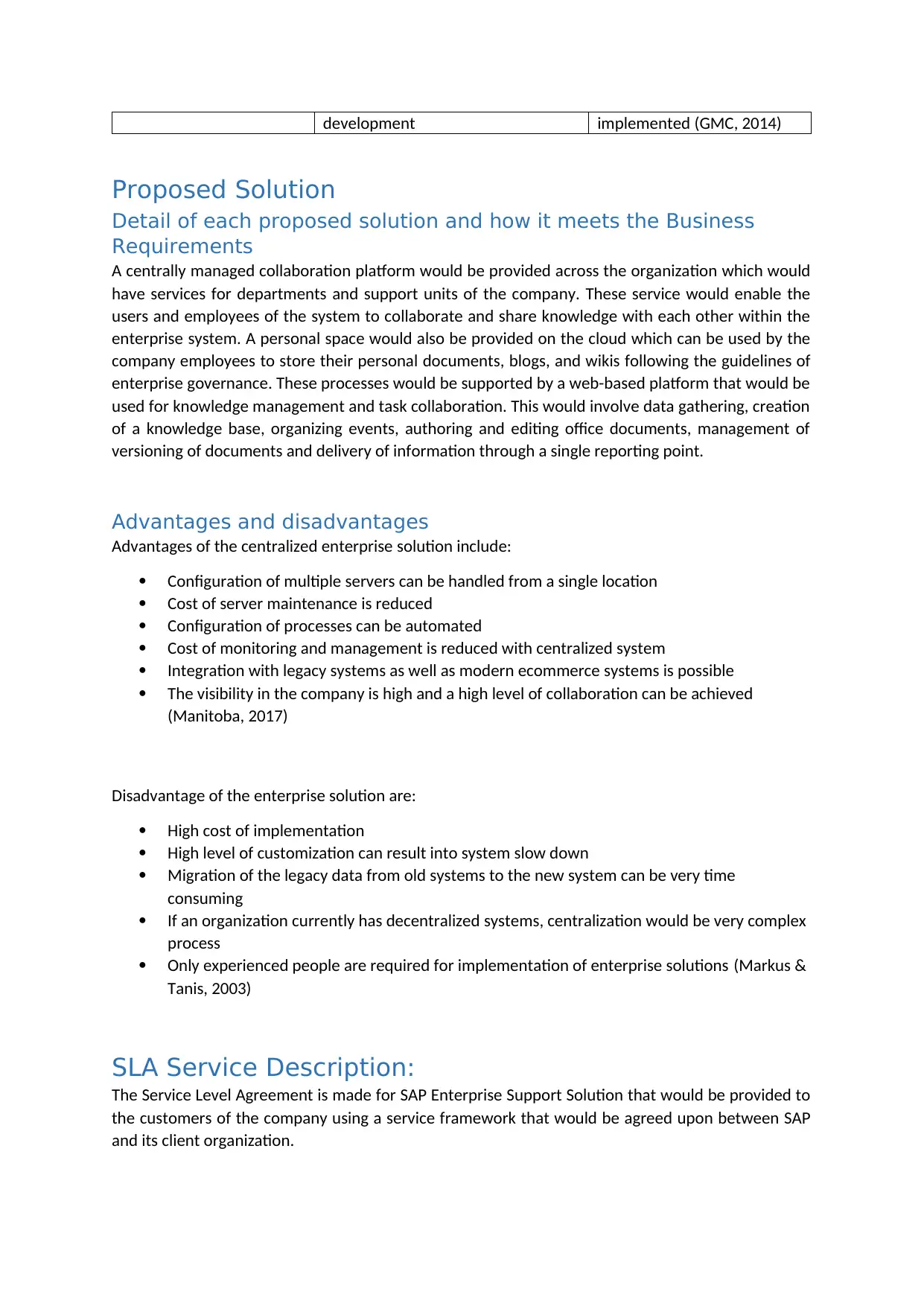
development implemented (GMC, 2014)
Proposed Solution
Detail of each proposed solution and how it meets the Business
Requirements
A centrally managed collaboration platform would be provided across the organization which would
have services for departments and support units of the company. These service would enable the
users and employees of the system to collaborate and share knowledge with each other within the
enterprise system. A personal space would also be provided on the cloud which can be used by the
company employees to store their personal documents, blogs, and wikis following the guidelines of
enterprise governance. These processes would be supported by a web-based platform that would be
used for knowledge management and task collaboration. This would involve data gathering, creation
of a knowledge base, organizing events, authoring and editing office documents, management of
versioning of documents and delivery of information through a single reporting point.
Advantages and disadvantages
Advantages of the centralized enterprise solution include:
Configuration of multiple servers can be handled from a single location
Cost of server maintenance is reduced
Configuration of processes can be automated
Cost of monitoring and management is reduced with centralized system
Integration with legacy systems as well as modern ecommerce systems is possible
The visibility in the company is high and a high level of collaboration can be achieved
(Manitoba, 2017)
Disadvantage of the enterprise solution are:
High cost of implementation
High level of customization can result into system slow down
Migration of the legacy data from old systems to the new system can be very time
consuming
If an organization currently has decentralized systems, centralization would be very complex
process
Only experienced people are required for implementation of enterprise solutions (Markus &
Tanis, 2003)
SLA Service Description:
The Service Level Agreement is made for SAP Enterprise Support Solution that would be provided to
the customers of the company using a service framework that would be agreed upon between SAP
and its client organization.
Proposed Solution
Detail of each proposed solution and how it meets the Business
Requirements
A centrally managed collaboration platform would be provided across the organization which would
have services for departments and support units of the company. These service would enable the
users and employees of the system to collaborate and share knowledge with each other within the
enterprise system. A personal space would also be provided on the cloud which can be used by the
company employees to store their personal documents, blogs, and wikis following the guidelines of
enterprise governance. These processes would be supported by a web-based platform that would be
used for knowledge management and task collaboration. This would involve data gathering, creation
of a knowledge base, organizing events, authoring and editing office documents, management of
versioning of documents and delivery of information through a single reporting point.
Advantages and disadvantages
Advantages of the centralized enterprise solution include:
Configuration of multiple servers can be handled from a single location
Cost of server maintenance is reduced
Configuration of processes can be automated
Cost of monitoring and management is reduced with centralized system
Integration with legacy systems as well as modern ecommerce systems is possible
The visibility in the company is high and a high level of collaboration can be achieved
(Manitoba, 2017)
Disadvantage of the enterprise solution are:
High cost of implementation
High level of customization can result into system slow down
Migration of the legacy data from old systems to the new system can be very time
consuming
If an organization currently has decentralized systems, centralization would be very complex
process
Only experienced people are required for implementation of enterprise solutions (Markus &
Tanis, 2003)
SLA Service Description:
The Service Level Agreement is made for SAP Enterprise Support Solution that would be provided to
the customers of the company using a service framework that would be agreed upon between SAP
and its client organization.
⊘ This is a preview!⊘
Do you want full access?
Subscribe today to unlock all pages.

Trusted by 1+ million students worldwide
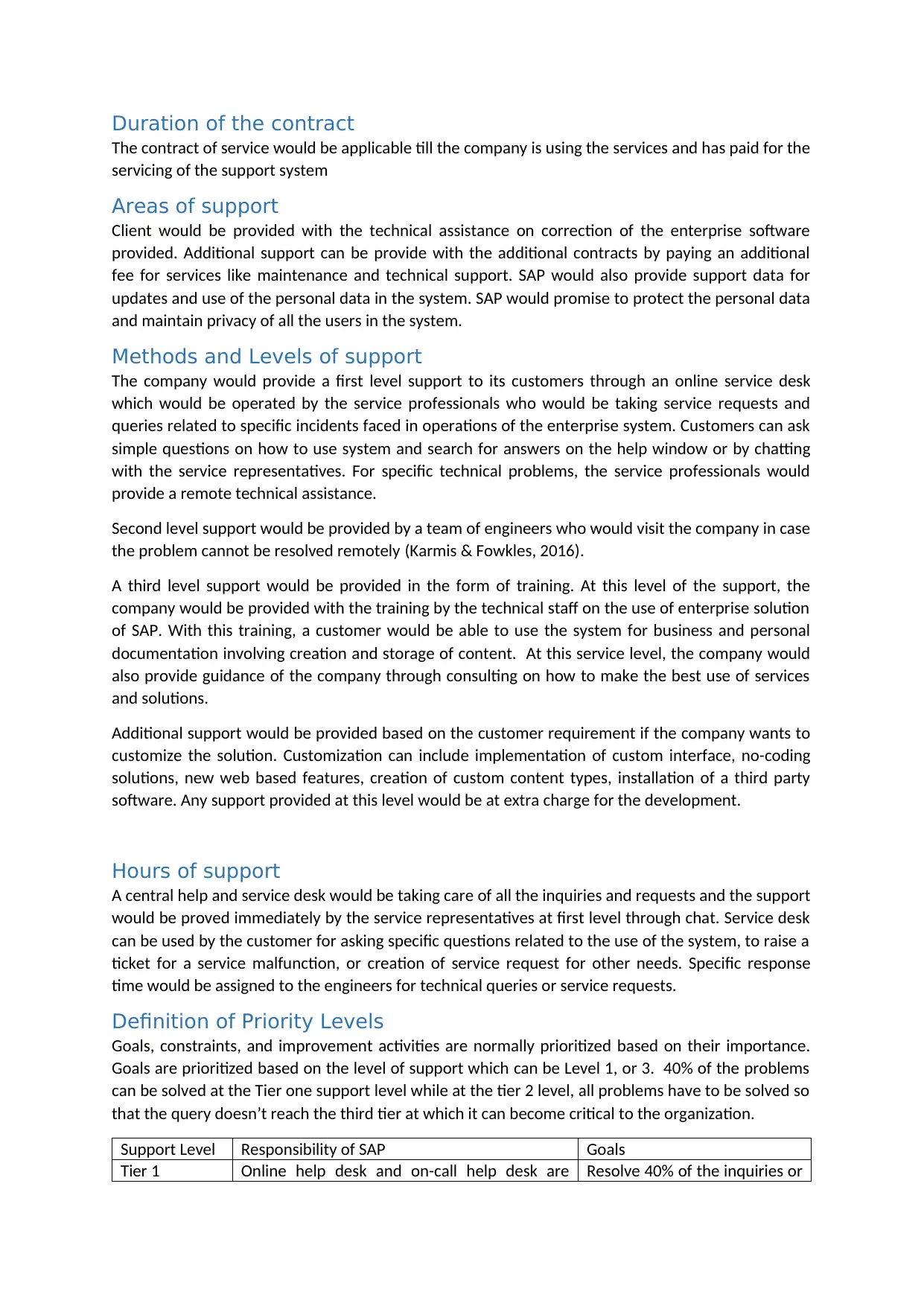
Duration of the contract
The contract of service would be applicable till the company is using the services and has paid for the
servicing of the support system
Areas of support
Client would be provided with the technical assistance on correction of the enterprise software
provided. Additional support can be provide with the additional contracts by paying an additional
fee for services like maintenance and technical support. SAP would also provide support data for
updates and use of the personal data in the system. SAP would promise to protect the personal data
and maintain privacy of all the users in the system.
Methods and Levels of support
The company would provide a first level support to its customers through an online service desk
which would be operated by the service professionals who would be taking service requests and
queries related to specific incidents faced in operations of the enterprise system. Customers can ask
simple questions on how to use system and search for answers on the help window or by chatting
with the service representatives. For specific technical problems, the service professionals would
provide a remote technical assistance.
Second level support would be provided by a team of engineers who would visit the company in case
the problem cannot be resolved remotely (Karmis & Fowkles, 2016).
A third level support would be provided in the form of training. At this level of the support, the
company would be provided with the training by the technical staff on the use of enterprise solution
of SAP. With this training, a customer would be able to use the system for business and personal
documentation involving creation and storage of content. At this service level, the company would
also provide guidance of the company through consulting on how to make the best use of services
and solutions.
Additional support would be provided based on the customer requirement if the company wants to
customize the solution. Customization can include implementation of custom interface, no-coding
solutions, new web based features, creation of custom content types, installation of a third party
software. Any support provided at this level would be at extra charge for the development.
Hours of support
A central help and service desk would be taking care of all the inquiries and requests and the support
would be proved immediately by the service representatives at first level through chat. Service desk
can be used by the customer for asking specific questions related to the use of the system, to raise a
ticket for a service malfunction, or creation of service request for other needs. Specific response
time would be assigned to the engineers for technical queries or service requests.
Definition of Priority Levels
Goals, constraints, and improvement activities are normally prioritized based on their importance.
Goals are prioritized based on the level of support which can be Level 1, or 3. 40% of the problems
can be solved at the Tier one support level while at the tier 2 level, all problems have to be solved so
that the query doesn’t reach the third tier at which it can become critical to the organization.
Support Level Responsibility of SAP Goals
Tier 1 Online help desk and on-call help desk are Resolve 40% of the inquiries or
The contract of service would be applicable till the company is using the services and has paid for the
servicing of the support system
Areas of support
Client would be provided with the technical assistance on correction of the enterprise software
provided. Additional support can be provide with the additional contracts by paying an additional
fee for services like maintenance and technical support. SAP would also provide support data for
updates and use of the personal data in the system. SAP would promise to protect the personal data
and maintain privacy of all the users in the system.
Methods and Levels of support
The company would provide a first level support to its customers through an online service desk
which would be operated by the service professionals who would be taking service requests and
queries related to specific incidents faced in operations of the enterprise system. Customers can ask
simple questions on how to use system and search for answers on the help window or by chatting
with the service representatives. For specific technical problems, the service professionals would
provide a remote technical assistance.
Second level support would be provided by a team of engineers who would visit the company in case
the problem cannot be resolved remotely (Karmis & Fowkles, 2016).
A third level support would be provided in the form of training. At this level of the support, the
company would be provided with the training by the technical staff on the use of enterprise solution
of SAP. With this training, a customer would be able to use the system for business and personal
documentation involving creation and storage of content. At this service level, the company would
also provide guidance of the company through consulting on how to make the best use of services
and solutions.
Additional support would be provided based on the customer requirement if the company wants to
customize the solution. Customization can include implementation of custom interface, no-coding
solutions, new web based features, creation of custom content types, installation of a third party
software. Any support provided at this level would be at extra charge for the development.
Hours of support
A central help and service desk would be taking care of all the inquiries and requests and the support
would be proved immediately by the service representatives at first level through chat. Service desk
can be used by the customer for asking specific questions related to the use of the system, to raise a
ticket for a service malfunction, or creation of service request for other needs. Specific response
time would be assigned to the engineers for technical queries or service requests.
Definition of Priority Levels
Goals, constraints, and improvement activities are normally prioritized based on their importance.
Goals are prioritized based on the level of support which can be Level 1, or 3. 40% of the problems
can be solved at the Tier one support level while at the tier 2 level, all problems have to be solved so
that the query doesn’t reach the third tier at which it can become critical to the organization.
Support Level Responsibility of SAP Goals
Tier 1 Online help desk and on-call help desk are Resolve 40% of the inquiries or
Paraphrase This Document
Need a fresh take? Get an instant paraphrase of this document with our AI Paraphraser
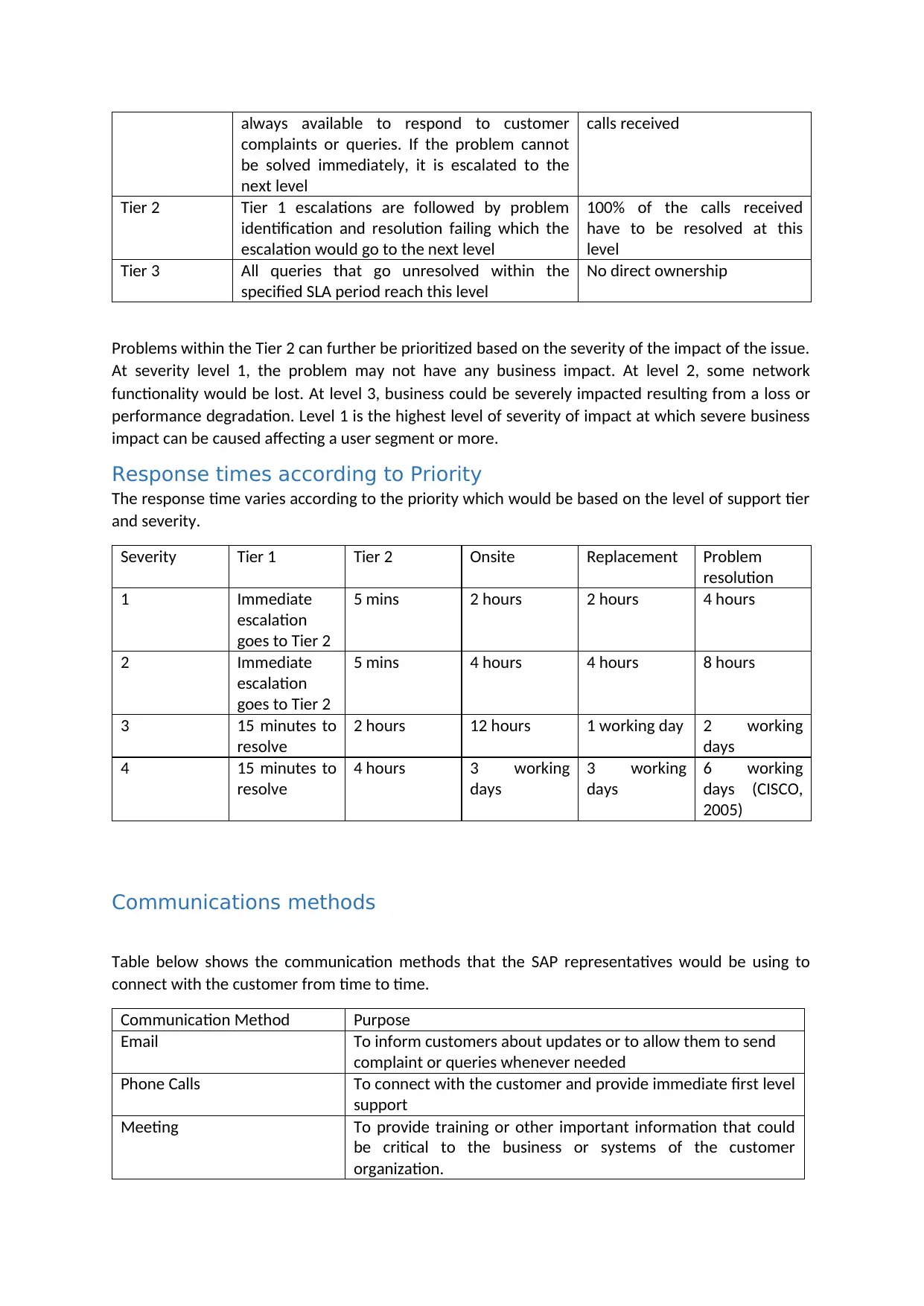
always available to respond to customer
complaints or queries. If the problem cannot
be solved immediately, it is escalated to the
next level
calls received
Tier 2 Tier 1 escalations are followed by problem
identification and resolution failing which the
escalation would go to the next level
100% of the calls received
have to be resolved at this
level
Tier 3 All queries that go unresolved within the
specified SLA period reach this level
No direct ownership
Problems within the Tier 2 can further be prioritized based on the severity of the impact of the issue.
At severity level 1, the problem may not have any business impact. At level 2, some network
functionality would be lost. At level 3, business could be severely impacted resulting from a loss or
performance degradation. Level 1 is the highest level of severity of impact at which severe business
impact can be caused affecting a user segment or more.
Response times according to Priority
The response time varies according to the priority which would be based on the level of support tier
and severity.
Severity Tier 1 Tier 2 Onsite Replacement Problem
resolution
1 Immediate
escalation
goes to Tier 2
5 mins 2 hours 2 hours 4 hours
2 Immediate
escalation
goes to Tier 2
5 mins 4 hours 4 hours 8 hours
3 15 minutes to
resolve
2 hours 12 hours 1 working day 2 working
days
4 15 minutes to
resolve
4 hours 3 working
days
3 working
days
6 working
days (CISCO,
2005)
Communications methods
Table below shows the communication methods that the SAP representatives would be using to
connect with the customer from time to time.
Communication Method Purpose
Email To inform customers about updates or to allow them to send
complaint or queries whenever needed
Phone Calls To connect with the customer and provide immediate first level
support
Meeting To provide training or other important information that could
be critical to the business or systems of the customer
organization.
complaints or queries. If the problem cannot
be solved immediately, it is escalated to the
next level
calls received
Tier 2 Tier 1 escalations are followed by problem
identification and resolution failing which the
escalation would go to the next level
100% of the calls received
have to be resolved at this
level
Tier 3 All queries that go unresolved within the
specified SLA period reach this level
No direct ownership
Problems within the Tier 2 can further be prioritized based on the severity of the impact of the issue.
At severity level 1, the problem may not have any business impact. At level 2, some network
functionality would be lost. At level 3, business could be severely impacted resulting from a loss or
performance degradation. Level 1 is the highest level of severity of impact at which severe business
impact can be caused affecting a user segment or more.
Response times according to Priority
The response time varies according to the priority which would be based on the level of support tier
and severity.
Severity Tier 1 Tier 2 Onsite Replacement Problem
resolution
1 Immediate
escalation
goes to Tier 2
5 mins 2 hours 2 hours 4 hours
2 Immediate
escalation
goes to Tier 2
5 mins 4 hours 4 hours 8 hours
3 15 minutes to
resolve
2 hours 12 hours 1 working day 2 working
days
4 15 minutes to
resolve
4 hours 3 working
days
3 working
days
6 working
days (CISCO,
2005)
Communications methods
Table below shows the communication methods that the SAP representatives would be using to
connect with the customer from time to time.
Communication Method Purpose
Email To inform customers about updates or to allow them to send
complaint or queries whenever needed
Phone Calls To connect with the customer and provide immediate first level
support
Meeting To provide training or other important information that could
be critical to the business or systems of the customer
organization.
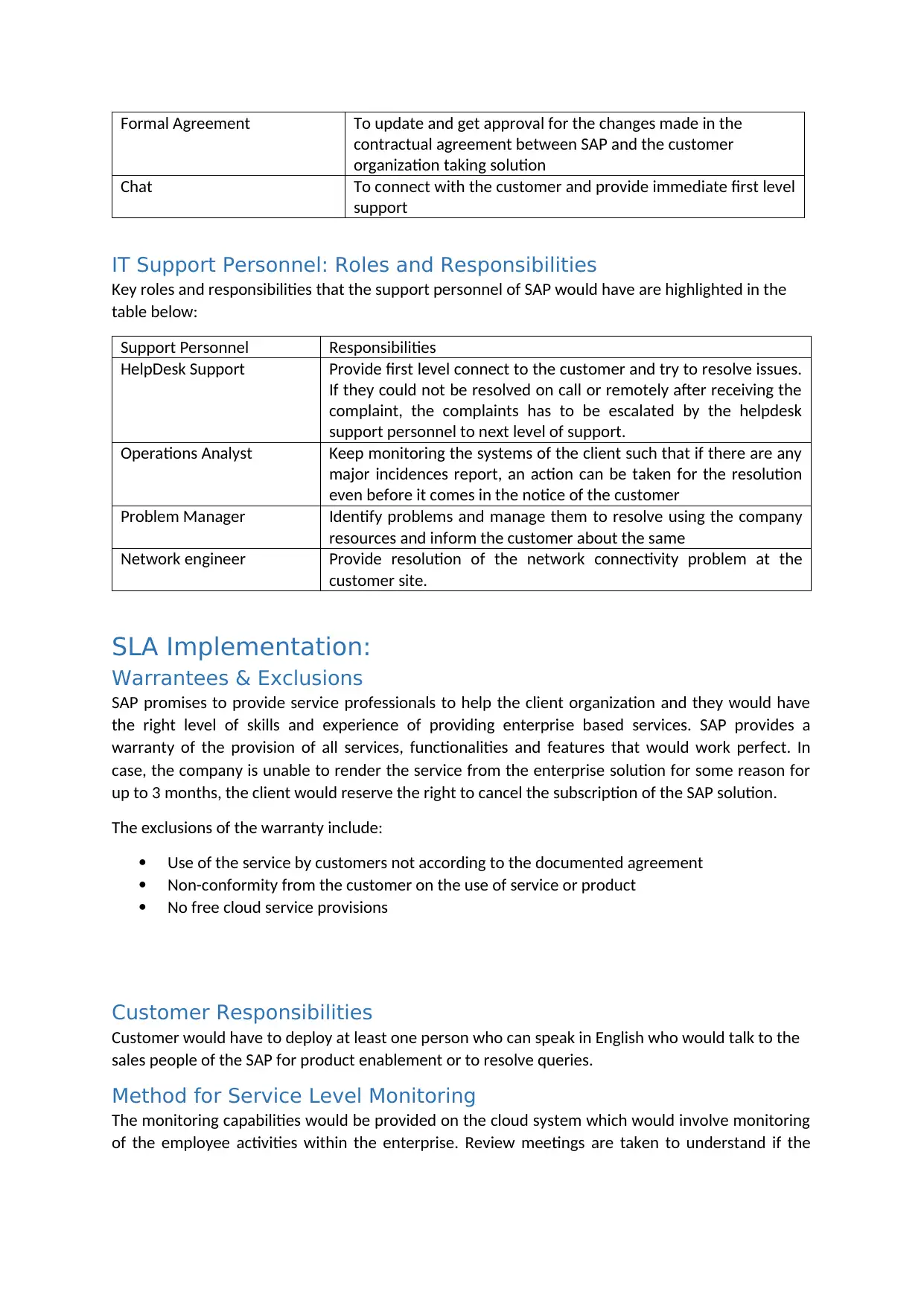
Formal Agreement To update and get approval for the changes made in the
contractual agreement between SAP and the customer
organization taking solution
Chat To connect with the customer and provide immediate first level
support
IT Support Personnel: Roles and Responsibilities
Key roles and responsibilities that the support personnel of SAP would have are highlighted in the
table below:
Support Personnel Responsibilities
HelpDesk Support Provide first level connect to the customer and try to resolve issues.
If they could not be resolved on call or remotely after receiving the
complaint, the complaints has to be escalated by the helpdesk
support personnel to next level of support.
Operations Analyst Keep monitoring the systems of the client such that if there are any
major incidences report, an action can be taken for the resolution
even before it comes in the notice of the customer
Problem Manager Identify problems and manage them to resolve using the company
resources and inform the customer about the same
Network engineer Provide resolution of the network connectivity problem at the
customer site.
SLA Implementation:
Warrantees & Exclusions
SAP promises to provide service professionals to help the client organization and they would have
the right level of skills and experience of providing enterprise based services. SAP provides a
warranty of the provision of all services, functionalities and features that would work perfect. In
case, the company is unable to render the service from the enterprise solution for some reason for
up to 3 months, the client would reserve the right to cancel the subscription of the SAP solution.
The exclusions of the warranty include:
Use of the service by customers not according to the documented agreement
Non-conformity from the customer on the use of service or product
No free cloud service provisions
Customer Responsibilities
Customer would have to deploy at least one person who can speak in English who would talk to the
sales people of the SAP for product enablement or to resolve queries.
Method for Service Level Monitoring
The monitoring capabilities would be provided on the cloud system which would involve monitoring
of the employee activities within the enterprise. Review meetings are taken to understand if the
contractual agreement between SAP and the customer
organization taking solution
Chat To connect with the customer and provide immediate first level
support
IT Support Personnel: Roles and Responsibilities
Key roles and responsibilities that the support personnel of SAP would have are highlighted in the
table below:
Support Personnel Responsibilities
HelpDesk Support Provide first level connect to the customer and try to resolve issues.
If they could not be resolved on call or remotely after receiving the
complaint, the complaints has to be escalated by the helpdesk
support personnel to next level of support.
Operations Analyst Keep monitoring the systems of the client such that if there are any
major incidences report, an action can be taken for the resolution
even before it comes in the notice of the customer
Problem Manager Identify problems and manage them to resolve using the company
resources and inform the customer about the same
Network engineer Provide resolution of the network connectivity problem at the
customer site.
SLA Implementation:
Warrantees & Exclusions
SAP promises to provide service professionals to help the client organization and they would have
the right level of skills and experience of providing enterprise based services. SAP provides a
warranty of the provision of all services, functionalities and features that would work perfect. In
case, the company is unable to render the service from the enterprise solution for some reason for
up to 3 months, the client would reserve the right to cancel the subscription of the SAP solution.
The exclusions of the warranty include:
Use of the service by customers not according to the documented agreement
Non-conformity from the customer on the use of service or product
No free cloud service provisions
Customer Responsibilities
Customer would have to deploy at least one person who can speak in English who would talk to the
sales people of the SAP for product enablement or to resolve queries.
Method for Service Level Monitoring
The monitoring capabilities would be provided on the cloud system which would involve monitoring
of the employee activities within the enterprise. Review meetings are taken to understand if the
⊘ This is a preview!⊘
Do you want full access?
Subscribe today to unlock all pages.

Trusted by 1+ million students worldwide
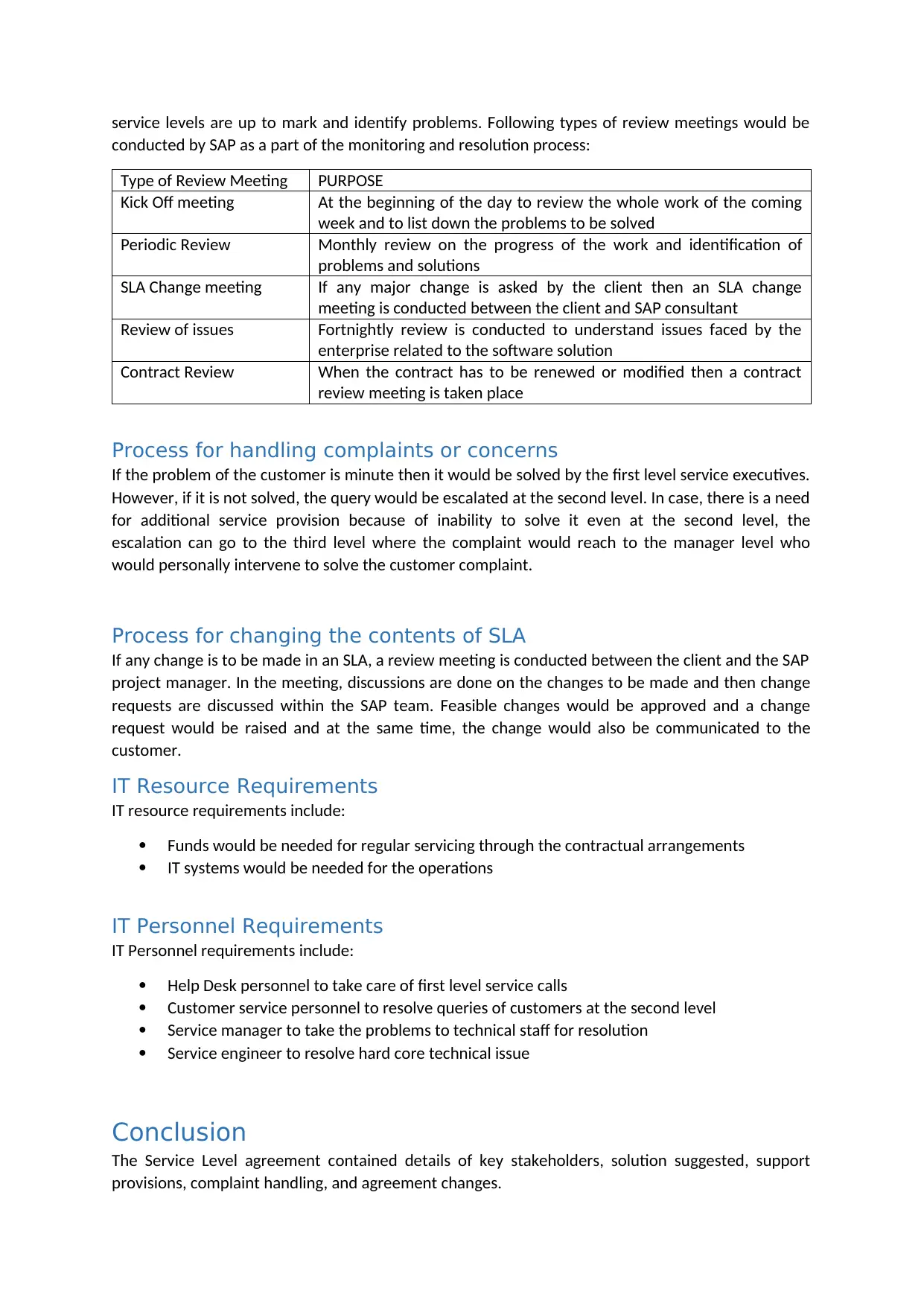
service levels are up to mark and identify problems. Following types of review meetings would be
conducted by SAP as a part of the monitoring and resolution process:
Type of Review Meeting PURPOSE
Kick Off meeting At the beginning of the day to review the whole work of the coming
week and to list down the problems to be solved
Periodic Review Monthly review on the progress of the work and identification of
problems and solutions
SLA Change meeting If any major change is asked by the client then an SLA change
meeting is conducted between the client and SAP consultant
Review of issues Fortnightly review is conducted to understand issues faced by the
enterprise related to the software solution
Contract Review When the contract has to be renewed or modified then a contract
review meeting is taken place
Process for handling complaints or concerns
If the problem of the customer is minute then it would be solved by the first level service executives.
However, if it is not solved, the query would be escalated at the second level. In case, there is a need
for additional service provision because of inability to solve it even at the second level, the
escalation can go to the third level where the complaint would reach to the manager level who
would personally intervene to solve the customer complaint.
Process for changing the contents of SLA
If any change is to be made in an SLA, a review meeting is conducted between the client and the SAP
project manager. In the meeting, discussions are done on the changes to be made and then change
requests are discussed within the SAP team. Feasible changes would be approved and a change
request would be raised and at the same time, the change would also be communicated to the
customer.
IT Resource Requirements
IT resource requirements include:
Funds would be needed for regular servicing through the contractual arrangements
IT systems would be needed for the operations
IT Personnel Requirements
IT Personnel requirements include:
Help Desk personnel to take care of first level service calls
Customer service personnel to resolve queries of customers at the second level
Service manager to take the problems to technical staff for resolution
Service engineer to resolve hard core technical issue
Conclusion
The Service Level agreement contained details of key stakeholders, solution suggested, support
provisions, complaint handling, and agreement changes.
conducted by SAP as a part of the monitoring and resolution process:
Type of Review Meeting PURPOSE
Kick Off meeting At the beginning of the day to review the whole work of the coming
week and to list down the problems to be solved
Periodic Review Monthly review on the progress of the work and identification of
problems and solutions
SLA Change meeting If any major change is asked by the client then an SLA change
meeting is conducted between the client and SAP consultant
Review of issues Fortnightly review is conducted to understand issues faced by the
enterprise related to the software solution
Contract Review When the contract has to be renewed or modified then a contract
review meeting is taken place
Process for handling complaints or concerns
If the problem of the customer is minute then it would be solved by the first level service executives.
However, if it is not solved, the query would be escalated at the second level. In case, there is a need
for additional service provision because of inability to solve it even at the second level, the
escalation can go to the third level where the complaint would reach to the manager level who
would personally intervene to solve the customer complaint.
Process for changing the contents of SLA
If any change is to be made in an SLA, a review meeting is conducted between the client and the SAP
project manager. In the meeting, discussions are done on the changes to be made and then change
requests are discussed within the SAP team. Feasible changes would be approved and a change
request would be raised and at the same time, the change would also be communicated to the
customer.
IT Resource Requirements
IT resource requirements include:
Funds would be needed for regular servicing through the contractual arrangements
IT systems would be needed for the operations
IT Personnel Requirements
IT Personnel requirements include:
Help Desk personnel to take care of first level service calls
Customer service personnel to resolve queries of customers at the second level
Service manager to take the problems to technical staff for resolution
Service engineer to resolve hard core technical issue
Conclusion
The Service Level agreement contained details of key stakeholders, solution suggested, support
provisions, complaint handling, and agreement changes.
Paraphrase This Document
Need a fresh take? Get an instant paraphrase of this document with our AI Paraphraser
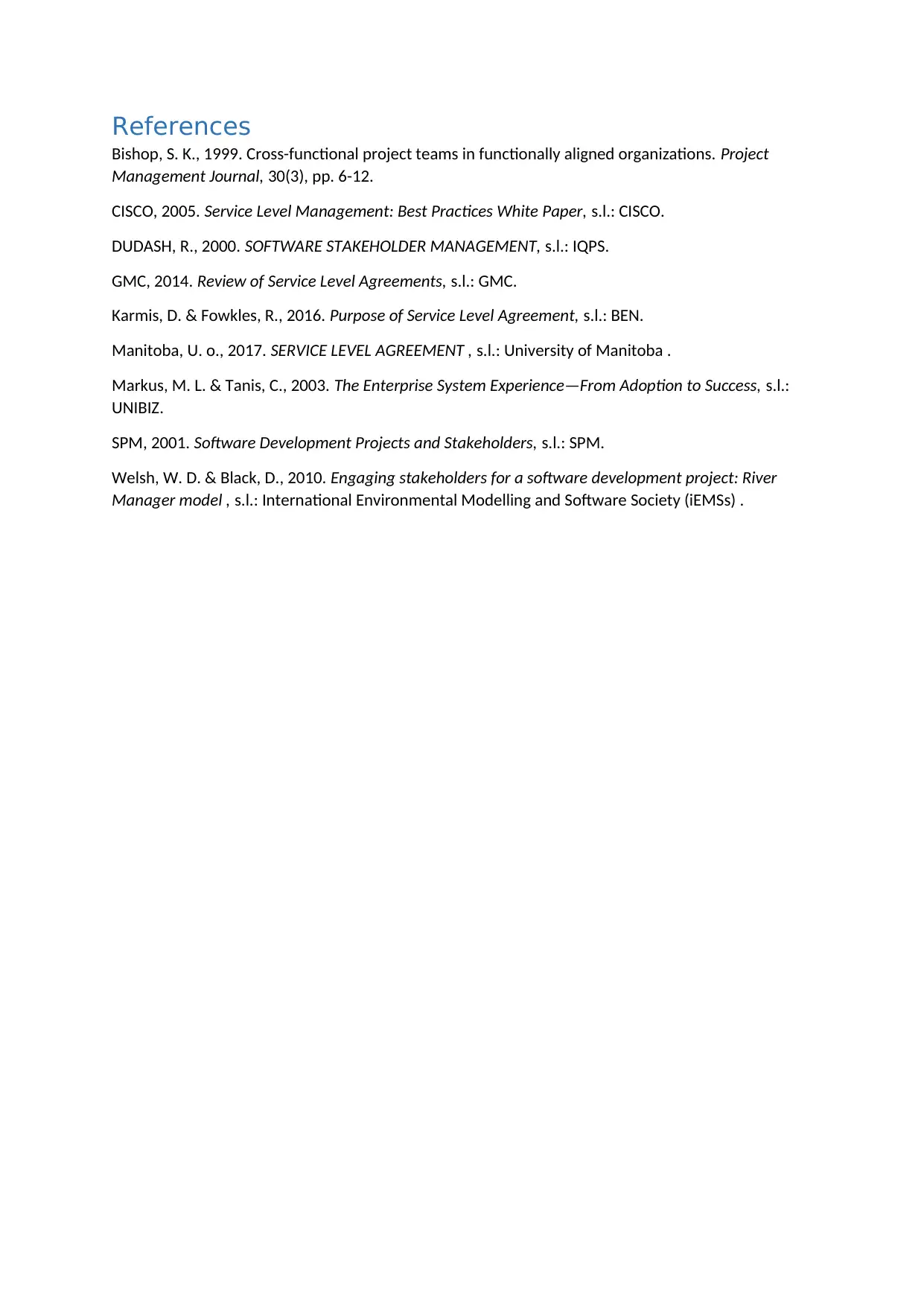
References
Bishop, S. K., 1999. Cross-functional project teams in functionally aligned organizations. Project
Management Journal, 30(3), pp. 6-12.
CISCO, 2005. Service Level Management: Best Practices White Paper, s.l.: CISCO.
DUDASH, R., 2000. SOFTWARE STAKEHOLDER MANAGEMENT, s.l.: IQPS.
GMC, 2014. Review of Service Level Agreements, s.l.: GMC.
Karmis, D. & Fowkles, R., 2016. Purpose of Service Level Agreement, s.l.: BEN.
Manitoba, U. o., 2017. SERVICE LEVEL AGREEMENT , s.l.: University of Manitoba .
Markus, M. L. & Tanis, C., 2003. The Enterprise System Experience—From Adoption to Success, s.l.:
UNIBIZ.
SPM, 2001. Software Development Projects and Stakeholders, s.l.: SPM.
Welsh, W. D. & Black, D., 2010. Engaging stakeholders for a software development project: River
Manager model , s.l.: International Environmental Modelling and Software Society (iEMSs) .
Bishop, S. K., 1999. Cross-functional project teams in functionally aligned organizations. Project
Management Journal, 30(3), pp. 6-12.
CISCO, 2005. Service Level Management: Best Practices White Paper, s.l.: CISCO.
DUDASH, R., 2000. SOFTWARE STAKEHOLDER MANAGEMENT, s.l.: IQPS.
GMC, 2014. Review of Service Level Agreements, s.l.: GMC.
Karmis, D. & Fowkles, R., 2016. Purpose of Service Level Agreement, s.l.: BEN.
Manitoba, U. o., 2017. SERVICE LEVEL AGREEMENT , s.l.: University of Manitoba .
Markus, M. L. & Tanis, C., 2003. The Enterprise System Experience—From Adoption to Success, s.l.:
UNIBIZ.
SPM, 2001. Software Development Projects and Stakeholders, s.l.: SPM.
Welsh, W. D. & Black, D., 2010. Engaging stakeholders for a software development project: River
Manager model , s.l.: International Environmental Modelling and Software Society (iEMSs) .
1 out of 8
Related Documents
Your All-in-One AI-Powered Toolkit for Academic Success.
+13062052269
info@desklib.com
Available 24*7 on WhatsApp / Email
![[object Object]](/_next/static/media/star-bottom.7253800d.svg)
Unlock your academic potential
Copyright © 2020–2025 A2Z Services. All Rights Reserved. Developed and managed by ZUCOL.




